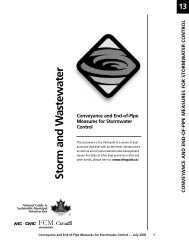Whitehorse Climate Change Adaptation Plan - Yukon College
Whitehorse Climate Change Adaptation Plan - Yukon College
Whitehorse Climate Change Adaptation Plan - Yukon College
You also want an ePaper? Increase the reach of your titles
YUMPU automatically turns print PDFs into web optimized ePapers that Google loves.
APPENDIX E - COMMUNITY OF WHITEHORSE RISK ASSESSMENT<br />
TIER II ASSESSMENT OF RISK: CLIMATE-CHANGE VULNERABILITY AND<br />
THE COMMUNITY OF WHITEHORSE<br />
Risk assessment is a common method for identifying priority vulnerability where there is a<br />
required community adaptation to climate change. Risk assessments are normally based on<br />
the analysis of the uncertainty and severity of a potential vulnerability. The assessment of<br />
risk completed for the WhiteCAP plan incorporated an additional variable that influences<br />
vulnerability: adaptive capacity. Adaptive capacity was integrated into the risk assessment as a<br />
measure of community preparedness under the assumption that if the community is prepared<br />
for a climate-related event, the vulnerability would be reduced. Priority risks are therefore<br />
characterized by high likelihood, high severity and low adaptive capacity. The characteristics<br />
assigned to vulnerabilities by the WhiteCAP planning team are provided below. The Tier II risk<br />
assessment also evaluated climate-related opportunities. These opportunities were prioritized<br />
by evaluating the benefits, the likelihood of the consequence emerging from shifting climate<br />
conditions, and how prepared the community is to profit from the consequence. Each sector of<br />
vulnerability is characterized at the opening of each section.<br />
Uncertainty and variability were two characteristics of climate change that were challenging<br />
to evaluate. These characteristics were assessed using a multiple environmental scenario<br />
methodology through which four possible scenarios of growth and climate change were created<br />
by the WhiteCAP planning team. The four scenarios allowed for the expression of climate change<br />
variability, such as declining or increasing water availability in the region, to 2050. Uncertainty<br />
was evaluated by the emergence of vulnerabilities across the range of scenarios. For example,<br />
an increase in the incidence of forest fire was common to all scenarios which made this<br />
vulnerability more likely to occur than one which only emerged in a single scenario, such as the<br />
emergence of significant health risks. A summary of the scenarios is provided in Appendix A.<br />
Hazards<br />
<strong>Whitehorse</strong> <strong>Climate</strong> <strong>Change</strong> <strong>Adaptation</strong> <strong>Plan</strong><br />
Hazards are characterized by climate-influenced disturbances at the landscape scale such as<br />
landslides, forest fires, floods, etc. Increasing winter temperatures, increased variability in water<br />
availability, as well as the more frequent occurrence of extreme weather events all increase the<br />
hazard risk for the community of <strong>Whitehorse</strong>.<br />
Community Consequences of Hazards<br />
Impact<br />
Likelihood<br />
Adaptive<br />
Capacity<br />
of Level<br />
H.1<br />
Consequences<br />
Community vulnerability to forest fire increases due to heavy<br />
fuel load, lighting, drought, wind, etc.<br />
H H L High<br />
H.2 Increased risk of catastrophic fire. H M L High<br />
H.3<br />
Egress from subdivisions becomes a problem during emergency<br />
situations.<br />
H M L High<br />
H.4<br />
Possibility of regional beetle infestation leading to more dead<br />
stands and increased risk of forest fire.<br />
H H L High<br />
Priority<br />
65

















